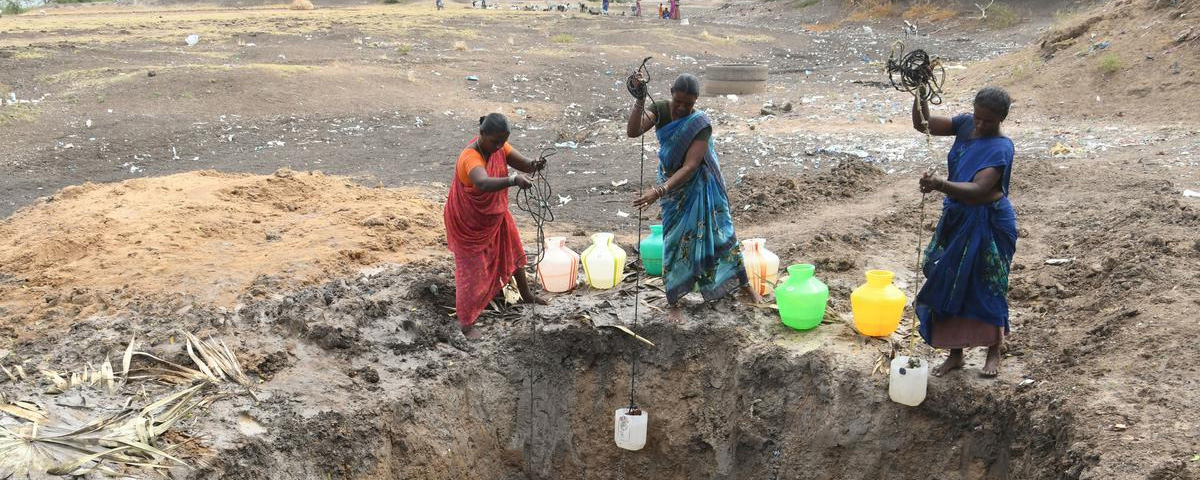Liquid Assets: Why India’s Water Crisis Is a Global Risk


India is facing a mounting water crisis that poses to be a looming threat to its economic development and social stability. With 18 percent of the world’s population but only 4 percent of its water resources, the country’s per capita water availability has fallen from 5,177 cubic metres in 1951 to just 1,486 cubic metres in 2021, according to the Central Water Commission (CWC). The Ministry of Jal Shakti projects this number could fall below 1,400 by 2040, classifying India as a water-stressed nation. If the country goes further on the downward scop of the curve, India will officially become a water-scarce country by 2030.
Groundwater depletion is one of the most acute contributors to the crisis. India extracts approximately 251 billion cubic metres of groundwater annually, making it the largest user of groundwater in the world, accounting for nearly 25% of global extraction. A 2023 report by the Central Ground Water Board (CGWB) classifies 17% of India’s 6,965 groundwater assessment blocks as over-exploited. In states like Punjab, Haryana, Rajasthan, and parts of Karnataka, groundwater levels are declining at a rate exceeding 1 metre per year.
In India, groundwater depletion is directly incentivised through input subsidies on electricity, fertiliser, and crop procurement. The Minimum Support Price (MSP) regime disproportionately benefits paddy and wheat cultivation, even in ecologically unsuitable regions.
The role of sand mining in exacerbating water insecurity is rarely addressed. Illegal and unregulated sand extraction from riverbeds alters river morphology, reduces base flow, and damages aquifers and floodplains. In states such as Uttar Pradesh, Madhya Pradesh, and Tamil Nadu, unchecked mining has deepened riverbeds by several metres, impairing their natural recharge capacity and increasing evaporation losses.
The agricultural sector consumes nearly 78 percent of India's freshwater resources. Government procurement policies and electricity subsidies have led to the widespread cultivation of water-intensive crops such as paddy and sugarcane in ecologically unsuitable regions. The lack of crop diversification and the absence of widespread adoption of water-efficient irrigation techniques have intensified pressure on limited water resources.
Rapid population growth in urban areas, combined with industrial expansion, has created demand that often outpaces supply. Infrastructure development has not kept pace with urban growth, resulting in unreliable water supply, overburdened sewage systems, and high levels of non-revenue water due to leakages and illegal structures.
India’s water infrastructure suffers not only from underinvestment but also from poor climate resilience. Large dams and canal networks, many constructed in the mid-20th century, were not designed for the hydrological volatility now observed due to climate change. During the monsoon months, many reservoirs overflow due to the lack of flood-buffering capacity and contingents, while prolonged dry periods shed light on the design flaws in water replenishment management. The Dam Safety Act of 2021 is a step towards modernising oversight, but over 70 percent of India’s dams are more than 25 years old and require retrofitting or structural audits.
While the country advocates for climate justice and equity in carbon budgeting, its water vulnerability is rarely foregrounded in UNFCCC submissions or climate diplomacy. This leaves critical opportunities untapped, such as climate-linked infrastructure finance, water-smart agriculture funding, or transboundary river climate risk. International donors and climate funds continue to direct limited resources towards India’s water sector compared to energy or transportation.
The Indian Meteorological Department has recorded a 10 percent decline in overall monsoon precipitation between 1950 and 2020, but more concerning is the sharp increase in inter and intra seasonal variability. Rainfall now arrives in fewer, more intense episodes, leading to both floods and ineffective aquifer recharge. This shift has diminished the efficacy of traditional water harvesting systems, particularly in semi-arid areas such as Telangana, Vidarbha, and central Madhya Pradesh. Moreover, the incidence of “dry spells within wet spells”, where short periods of extreme rain are followed by rainless days has risen by nearly 50 percent, disrupting planting cycles and agricultural water demand planning.
In parallel, water quality deterioration is compounding the scarcity issue. Pollution from untreated sewage, chemical runoff, and industrial effluents has rendered large portions of rivers and lakes unfit for human or agricultural use. According to recent estimates, more than 70% of surface water in India is contaminated.
As water resources are strained, their competing uses are becoming flashpoints. Agriculture demands priority in volume, but cities, expanding rapidly, cannot survive without large amounts of water. Urban centres have seen increasing reliance on groundwater and water imported from distant basins and foreign countries. This overreach, however, is unsustainable. Many cities suffer from high levels of non-revenue water, inadequate treatment capacity, and growing dependence on private tankers and borewells
India’s growing reliance on bottled water and private water markets reflects institutional failure. As of 2024, the packaged drinking water market is valued at over ₹24,000 crore and growing at 20 percent annually. In urban and peri-urban zones, informal water vendors operate fleets of tankers that extract from unregulated borewells and sell water at variable prices, up to ₹20 per litre in peak summer. This commodification of water creates deep inequities. While the wealthy can buy their way out of scarcity, the urban poor are left with unreliable public taps or handpumps, many of which are contaminated or dry.
The consequences are already visible. Water scarcity affects food production, causes regional economic disparity, and fuels rural distress. Healthcare is deteriorating in water-insecure areas. Access to safe drinking water remains inconsistent, especially in rural and peri-urban populations. Untreated sewage and industrial effluents continue to pollute rivers, lakes, and even groundwater.
The World Health Organization (WHO) estimates that 163 million Indians lack access to clean drinking water, and 210 million lack basic sanitation. The Central Pollution Control Board (CPCB) reports that over 70 percent of surface water in India is contaminated with faecal and chemical pollutants. Every year, around 38 million people in India are affected by waterborne diseases. Diarrhoea alone accounts for over 10 percent of child mortality. Additionally, arsenic contamination in groundwater, particularly in parts of Bihar, West Bengal, and Assam cause long-term risks such as cancer and developmental issues.
The emerging challenge of microplastic contamination in water systems is largely ignored. Recent studies by the Indian Institute of Technology have found alarming levels of microplastic particles in river systems such as the Yamuna and Mithi, and even in groundwater samples near urban landfills.
Climate change is intensifying the crisis. India’s average temperature has increased by about 0.7°C between 1901 and 2018, and is projected to rise by 2.4-4.4°C by the end of the century under the IPCC’s high-emission scenarios. The India Meteorological Department reported a 6 percent deficit in the 2023 southwest monsoon. Uneven rainfall has contributed to both droughts and urban flooding. The glacial retreat in the Himalayas, the source of major Indian rivers is accelerating, potentially threatening the long-term flow of the Indus, Ganges, and Brahmaputra river basins, which support over 700 million people.
To address this complex crisis, India must adopt a multidimensional, long-term strategy rooted in sustainability and inclusivity. First, agricultural practices need urgent reform. Policymakers must shift incentives away from water-intensive crops and towards millets, pulses, and oilseeds that are more suited to local agro-climatic conditions. The success of SRI (System of Rice Intensification) in Tamil Nadu and direct seeding of rice in Punjab has shown that innovative techniques can significantly reduce water use without sacrificing yields. Agricultural extension services should be revitalised to educate farmers on water-efficient methods like drip and sprinkler irrigation.
Second, urban water governance needs a complete overhaul. Smart metering, leakage control, and decentralised wastewater treatment systems can reduce wastage and promote recycling. Urban planning must integrate water-sensitive design principles to reduce runoff and increase recharge through green infrastructure.
India still lacks a legally binding national water policy. Water remains a state subject under the Constitution, leading to fragmented and often contradictory approaches. The Draft National Water Policy 2020 proposed a framework for integrated water resource management, sustainable groundwater use, and wastewater recycling, but it remains under review. Meanwhile, state-level policies continue to subsidise water-intensive practices, especially in agriculture, with limited incentive for conservation.
Insurance and financial risk mechanisms around water scarcity remain underdeveloped. Unlike agricultural crop insurance, which has partial state support, there are virtually no instruments to insure against industrial water-related losses. The World Economic Forum has warned that water crises rank among the top five risks to global business continuity, yet India’s financial sector remains underprepared to quantify or price water-related risk at either rural or national level.
The Jal Jeevan Mission, launched in 2019, seeks to provide functional household tap connections (FHTCs) to all rural households by 2024. As of July 2025, 72% of rural households reportedly have access to piped water, up from 16% in 2019, according to the Ministry of Jal Shakti. However, several states, particularly in eastern and central India are lagging behind. Desalination has com up as a last-resort solution. Chennai currently operates two desalination plants with a combined capacity of 200 MLD, and an additional 400 MLD is planned. However, desalination is energy-intensive, costly (₹70–₹90 per kilolitre), and has ecological consequences due to saline brine discharge into marine ecosystems.
The Atal Bhujal Yojana, supported by the World Bank, focuses on participatory groundwater management in 7 states covering over 8300 gram panchayats. The scheme has encouraged community water budgeting and aquifer mapping, with early signs of improvement in groundwater levels.
India’s water crisis is no longer an environmental issue alone. It has evolved into a multi-layered risk architecture that intersects fiscal planning, public health, national security, trade policy, and international relations. Addressing it requires far more than infrastructure. It demands governance reform, scientific innovation, legal enforceability, fiscal reallocation, and systemic accountability.
Dhanishtha De is a dedicated and inquisitive journalist contributing to Cult Current.